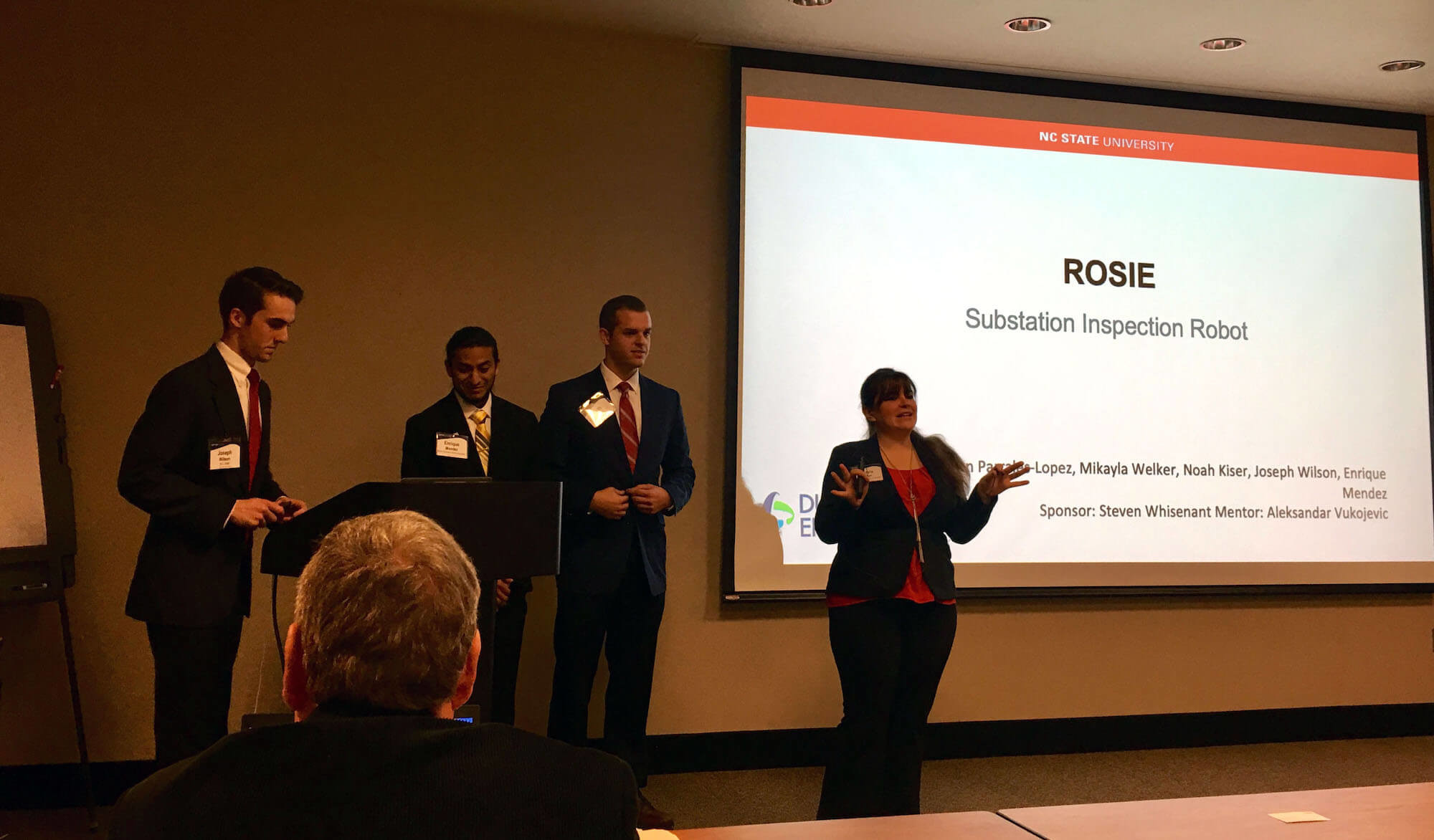
Senior Design Teams Present
With Design Day on the horizon, one team got to present its work-in-progress to its sponsor at the Fall Industry Meeting of CAPER in Charlotte. Check out more Senior Design projects at McKimmon on Dec 6, 1-4pm.
December 2, 2019 ![]() Charles Hall
Charles Hall
As undergraduate students complete the final year of their electrical or computer engineering degree, they embark on one of the most challenging and rewarding projects of their academic experience. Over the course of two semesters, students work in teams to solve real-world challenges as part of the Senior Design program. These projects, supported by industry and other academic partners give students first-hand experience in project management, lifecycle development, and problem-solving that goes beyond the classroom.
Since the first capstone project requirement in 1992, thousands of ECE students have gone through the Senior Design program, with projects ranging from video game arcades to stair climbing robots, from elephant early-warning systems to electrical grid inspection systems.
At the end of each semester, students present at Design Day, showing off their final functioning project to students, industry, and the community. Teams also get opportunities to present their work to external audiences, going beyond the typical academics and representing NC State in national and international venues.
ECE Senior Design
The goal of the ECE Senior Design’s first semester is to establish product requirements and prove the viability of concept architectures by early prototyping of key subsystems. This is followed in the second semester with progressively maturing prototyping iterations leading to a fully integrated product to be demonstrated at Design Day.
Join us at the McKimmon Center on December 6, 2019, from 1:00 – 4:00 p.m. to see these projects, alongside more than 50 other impressive projects by talented ECE students.
Substation Inspection Robot
One such team—the Substation Inspection Robot—presented in their first semester to industry and academia at the industry and advisory board meeting of the Center for Advanced Power Engineering Research (CAPER) in Charlotte, NC on November 14, 2019.
The ambitious goal of this project is to develop an inspection robot product with live-stream, high-quality tilt-pan-zoom cameras and infrared sensors that can be remotely controlled through Wi-Fi to perform substation inspection duties equivalent to the current “live-person on-site” method.
“Already, the students had to solve early architectural challenges in the selection of cameras, communications strategies, and real-time hardware/software for integrated object avoidance sensing and joystick motion control of their chosen battery-powered robotics drive platform,” explained Bobby Compton, Director of ECE Senior Design.
The team is now prototyping initial key subsystems for their first demos at Design Day on December 6, 2019.
This ambitious project is being mentored by Duke Energy’s, Aleksandar Vukojevic, who is the Manager of Technology Development in Duke’s Emerging Technology Office and is sponsored by Steven Whisenant, Lead Engineer at Duke Energy, and Steering Committee Chair of CAPER.
Cognitive Telescope Network
Another industry-sponsored project on display at the upcoming Design Day is the Cognitive Telescope Network, under the mentorship of IBM’s Arunava Muzumda and sponsored by Andy Rindos, head of IBM’s Research Triangle Park Center for Advanced Studies.
Telescopic followup—by the very limited number of capable telescopes—of transient astronomical events is one of the most desirable and scientifically useful activities in modern observational astronomy. However, very often transients are poorly localized on the sky and telescopes have a limited field of view thus pinpointing the transient source is often a daunting task. The Cognitive Telescope Network (CTN) will be a framework that takes notifications of transient events and intelligently instructs a network of submeter telescopes mapped into a grid and observe a large region of the sky that likely contains the transient event based on the geolocation weather and properties of the individual telescopes. The goal of CTN is to collect the data from this network of small telescopes evaluate and classify that data to identify the most likely candidates for the transient being hunted and deliver the results to the astronomer community for further analysis by larger telescopes for directed and focused observations.
“Several Senior Design projects have participated in this initiative,” commented Rachana Gupta, associate director of ECE Senior Design. “They’re tackling various challenges including how to process the astronomical images, how to set up the commander and server for each telescope, and how to ensure telescope safety during remote operation.”
In May 2019, a team of students (Hussain Arif, Daniel Palumbo, and Jacob Bouren) successfully designed and developed a system called “Observing Director for CTN,” which is a central system deciding how several telescopes at a certain locations on earth should be calibrated and organized to capture an event correctly based on the weather conditions, location on earth, time of event, time of the day, and telescope parameters. In Fall 2019, another team of students (Ishan Jolly, Kyra MacLean, and Ryan Lipski) is taking the project further by developing a mathematical optimization algorithm to decide the best way to rearrange the telescopes to capture most of the event.
CTN work done by several senior design teams has been presented by students, IBM sponsors and mentors at many events and conferences over the years including IBM Open Table, Watson Bootcamp Channel at Northwestern University, “Patterns for Big Idea Projects”, The SPS Symposium, and more.
